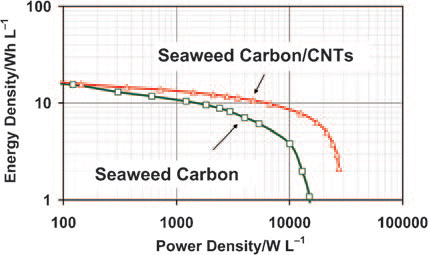High density materials for supercapacitor electrodes can be obtained by one-step pyrolysis of biopolymers extracted from seaweeds or of seaweeds themselves. Seaweed-based materials have high capacitance values due to their high oxygen content. However, their low conductivity and poorly developed specific surface area means there is still room for improvement.
François Béguin and co-workers, CNRS-University, France, have investigated the use of multiwalled carbon nanotubes (CNTs) as nanotexturing agents. They use a CNT/seaweed blend, which undergoes pyrolysis to produce a nanocomposite that combines the high capacitance of seaweed with the high conductivity of nanotubes.
As a consequence, at 10 s discharge time, the volumetric energy density extracted from a supercapacitor was 1.6 times higher for the composite containing 10 wt % CNTs than for seaweed-based carbon.

Image: (c) Wiley-VCH
- Carbon Nanotubes as Nanotexturing Agents for High Power Supercapacitors Based on Seaweed Carbons
E. Raymundo-Piñero, M. Cadek, M. Wachtler, F. Béguin,
ChemSusChem 2011.
DOI: 10.1002/cssc.201000376


